What Is Last Mile Logistics in 2024? Trends and Software
What is last mile logistics? How is it different from first mile logistics and middle mile delivery? How can you optimize the last mile? And is it the only supply chain operation worth optimizing?
These are only a few of the numerous last mile logistics frequently asked questions every logistics professional should know the answer to. For this reason, Route4Me’s last mile experts have compiled a list of the most common questions asked by our customers and answered them all in a succinct and easy-to-understand manner.
Inside this last mile logistics guide, you’ll discover not only theoretical definitions but also real-life examples, case studies, last mile statistics, the most sought-after last mile software, and a lot more.
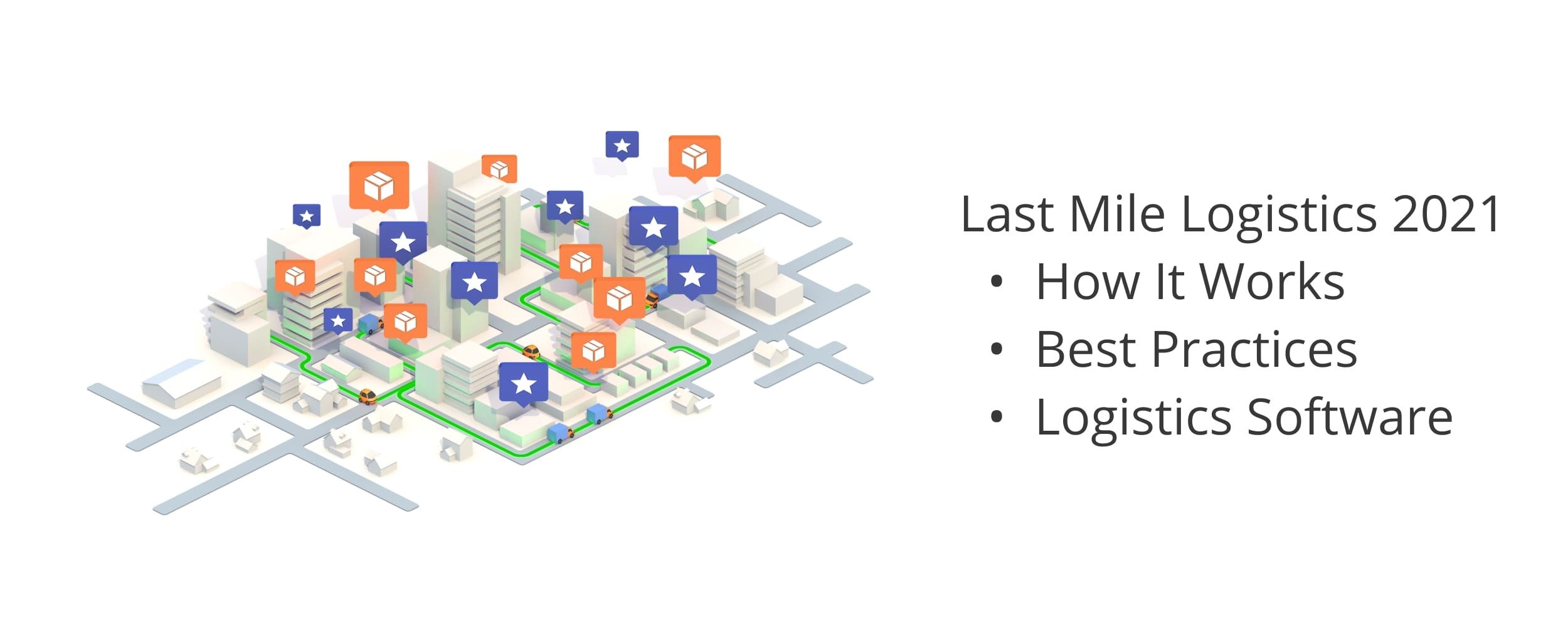
Table of Contents
Last Mile Logistics Definition
The last mile logistics definition encompasses all the logistics operations, resources, last mile technology, and processes necessary to store, package, label, and transport goods from a last mile hub to the end customers. Such last mile processes and technologies can include:
- Route planning for warehouse order pickers
- Route optimization and route scheduling for delivery drivers
- Driver tracking software
- Package barcode scanners/apps
- Delivery fleets
- Human resources
- Fleet management software
- Proof of delivery (POD) software and/or devices
- And a lot more!
These processes and tools are carefully pieced together to ensure maximum last mile logistics operational efficiency and offer customers a frictionless delivery experience. On the same note, customer experience should be a top priority for every last mile carrier and delivery service provider out there. Read on to discover why last mile logistics is important and how it is connected to customer loyalty.
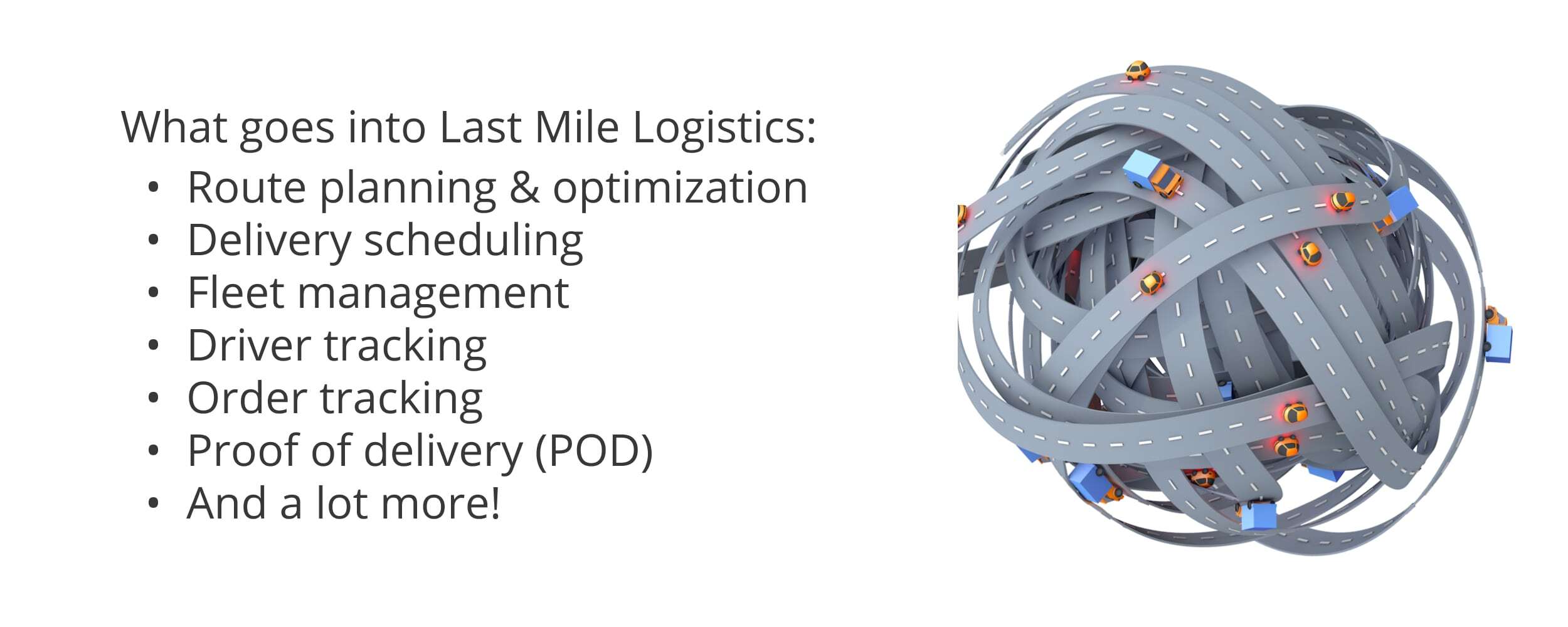
First Mile vs Last Mile Logistics
The difference between first mile and last mile logistics resides in the fact that the first mile refers to the movement of orders from the manufacturer to a warehouse or last mile distribution hub, and the last mile is defined as the delivery of goods from a warehouse, fulfillment center, dark store, etc. to the end customer. So, when it comes to first mile vs last mile logistics, the distinction resides in the destination to which the goods need to be delivered.
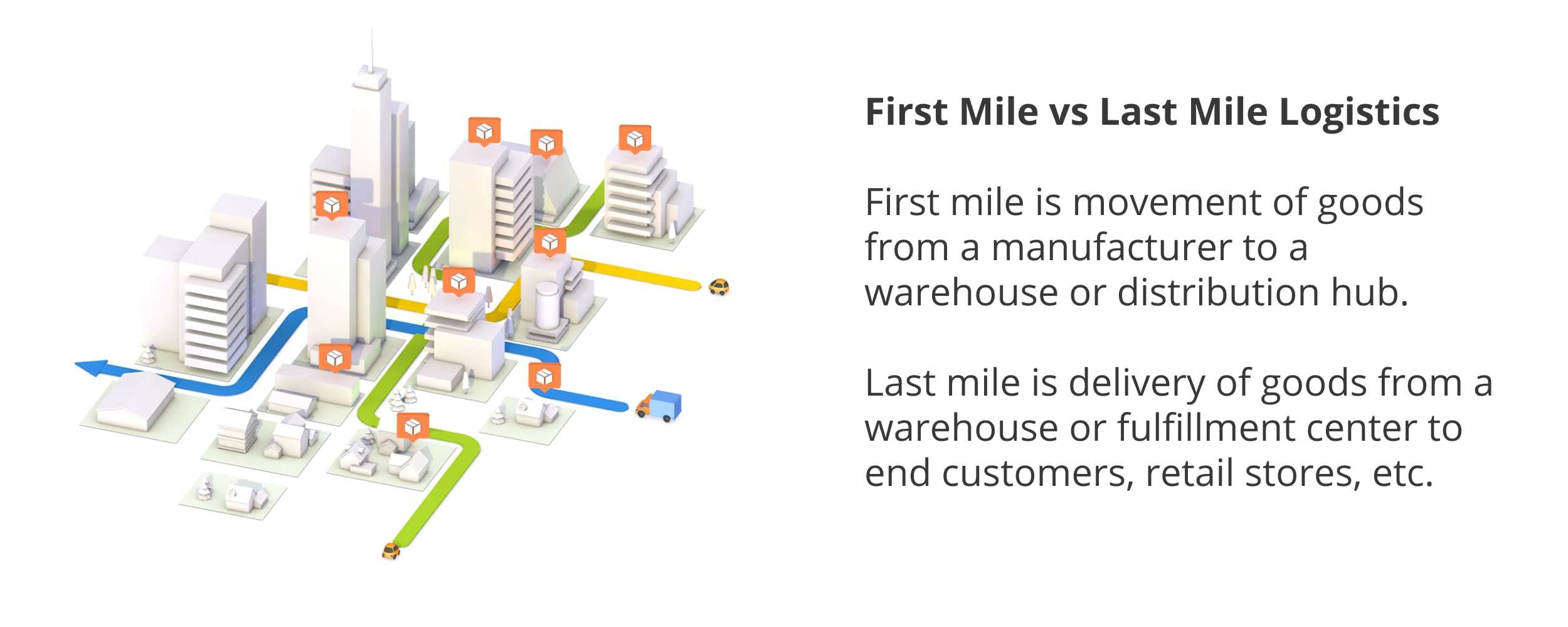
The core definition of the first mile refers to the first leg of the supply chain. However, since the supply chain of each business can be different, first mile logistics can take different forms across industries. For example, for manufacturers, the first mile represents the journey a product makes from the moment it leaves the production plant to the second it reaches a distribution hub. In contrast, for eCommerce businesses, the first mile might begin in a retail store and end in the retailer’s distribution center.
On the other hand, the definition of last mile shipping is consistent across all logistics-focused businesses: the last mile represents the final mile of the supply chain during which products are delivered to customers.
By reading further, you can learn more about first mile vs last mile logistics as well as the middle mile.
Middle Mile vs Final Mile
Similar to first mile vs last mile, the difference between middle mile and last mile logistics is determined by the transportation sequence within the supply chain. Specifically, the middle mile comes after the first mile and is also known as second mile delivery. The middle mile represents the transportation of goods between warehouses and fulfillment centers. In comparison, the last mile deals with delivering those goods to those who ordered them.
Another difference between middle mile vs last mile logistics consists of the character of the routes of both supply chain stages. Particularly, the first mile routes are mostly dynamic. In detail, along a last mile route, customers might make last-minute changes, such as modifying their delivery addresses, delaying the delivery date, etc. On the other hand, middle mile routes are usually fixed and have a constant schedule with fewer stops and fewer pieces (but greater volume) to unload at each stop.
With Route4Me, you can plan routes for both the middle mile and last mile. Specifically, Route4Me’s last mile software features tools for dynamic route optimization as well as recurring routing and delivery scheduling.
Keep reading to learn more about the differences between the first mile, middle mile, and last mile.
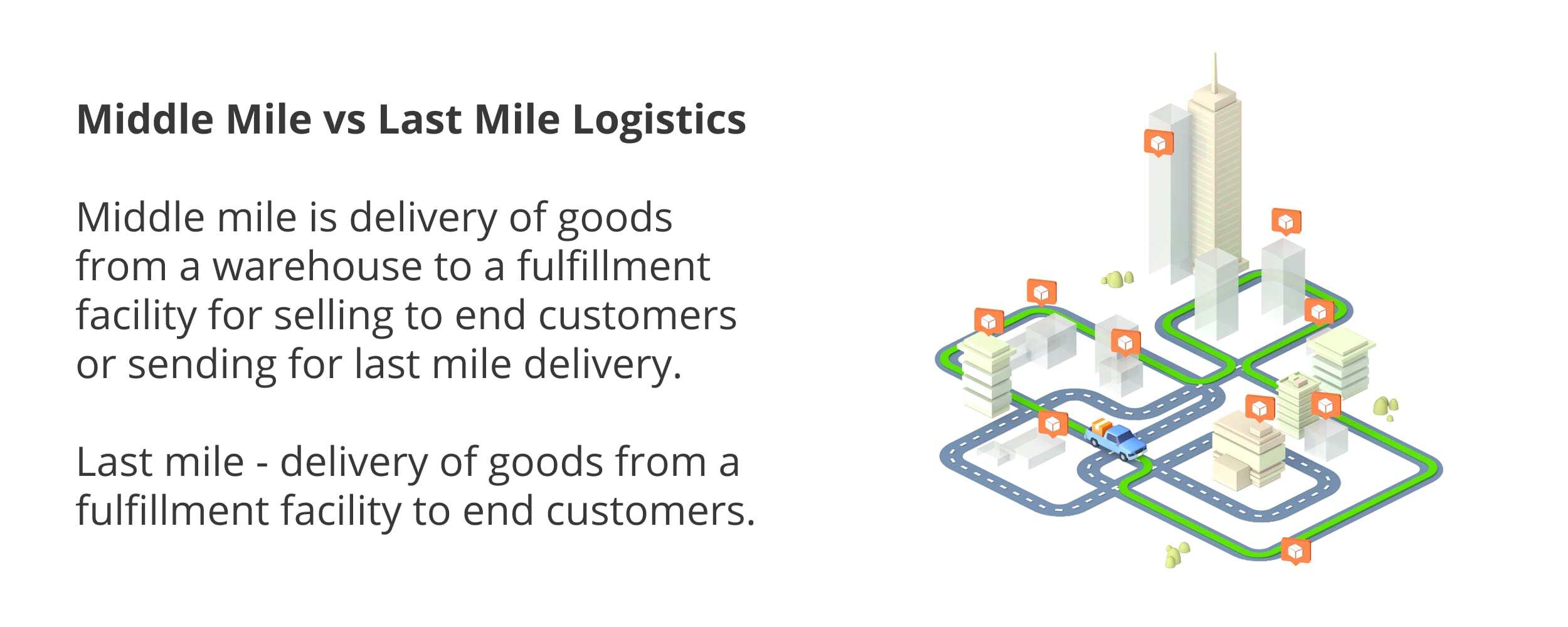
Last Mile Logistics Frequently Asked Questions
Below, you’ll find the answers to the most frequently asked questions (FAQs) about the last mile. Our customers have asked these last mile logistics FAQs over the decades, and our last mile experts have put together the answers to help you better understand this part of the supply chain as well as find ways to optimize your last mile delivery operations to grow your business.
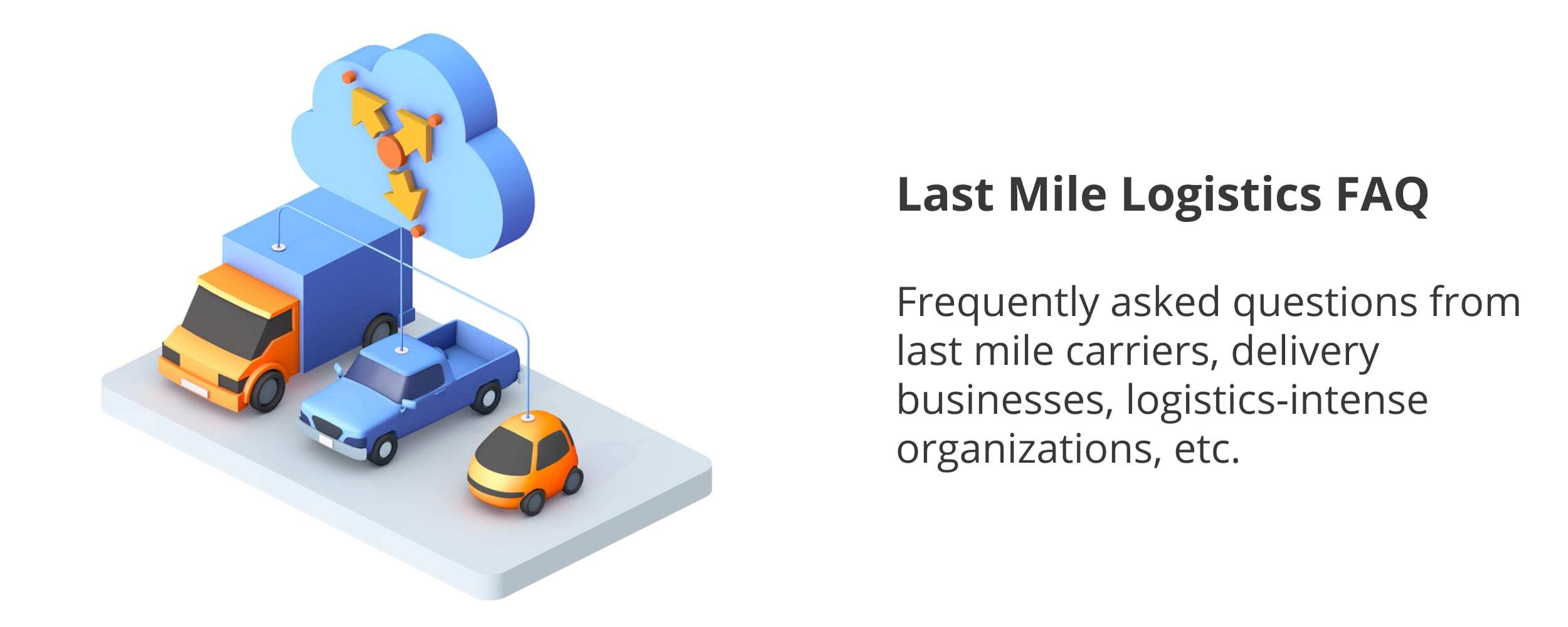
The term last mile in logistics refers to the last leg of a product’s journey and the final miles within the supply chain. Particularly, the last mile represents the actual delivery of packages from a fulfillment center or transportation hub to the final delivery destination. The delivery destination can vary from smart lockers, office addresses, pickup points, and more. However, home delivery is the most popular parcel delivery method, being preferred by the majority of customers today. This process is very resource-intensive and accounts for more than half of the total cost of shipping, and takes over 40% of the supply chain-related expenses.
Aside from the big last mile logistics costs, last mile carriers have to handle additional orchestration challenges dynamically to ensure a frictionless customer experience. And with Route4Me, dynamic routing and fleet management have never been easier. Concretely, Route4Me’s last mile software offers delivery businesses the ability to:
- Reduce operational costs and fuel consumption as well as minimize the organization’s carbon footprint
- Maximize parcel volume without investing in additional last mile logistics assets and human resources
- Increase customer satisfaction and driver retention rates
- Orchestrate dynamic routes and oversee drivers’ progress in real-time
- And much more!
Read on to discover more flexible features offered by Route4Me and how these can help you win the last mile.
First mile logistics is the first leg of the supply chain where manufactured goods are transported from the production facility to a warehouse from where the products will be forwarded further. Moreover, since it’s the first step in transporting orders, efficient first mile logistics is crucial for the well-being of the entire delivery chain. For example, the delays happening during the first mile will reflect in the following supply chain miles, and ultimately resulting in a poor customer experience.
As opposed to the last mile, within the first mile, goods are moved in bulk, and the first mile routes have only one stop – the distribution hub or warehouse. On the other hand, final mile delivery implies taking products out of pallets, sorting, loading them into vans, routing addresses, etc.
Keep reading to learn more about first mile middle mile last mile logistics.
Middle mile logistics refers to the process of transporting goods from a first mile warehouse to a last mile fulfillment center. So, middle mile takes on where first mile left off. Similar to the first mile, the middle mile delivery has fixed routes to transport products from point A to point B, oftentimes in bulk (i.e., shipping containers). Once the goods are unloaded at the destination, the first mile logistics processes begin. These include handling, unpacking, warehousing, delivery, etc.
Since the middle mile is extremely repetitive, it can offer opportunities for automation. For instance, Route4Me’s fastest route planning software can help logistics professionals automate route planning, route scheduling, and route dispatch for middle mile delivery.
Last mile logistics is the final mile in the supply chain and entails the shipping of packages to customers at their preferred address (i.e., home delivery, smart locker, retail store, office address, pickup point, etc.). Logistics professionals oftentimes refer to last mile logistics as final mile logistics or “the final mile.”
Compared to the first mile and middle mile, the last mile is the most expensive and time-consuming supply chain activity. Namely, the last mile encompasses multiple detail-oriented logistics processes such as:
- Unpacking, sorting, handling, loading each order prom pallets
- Planning the most efficient multi stop routes with the recipients’ addresses
- Dispatching the routes to the right drivers as per drivers’ skills, schedule, and experience
- Continuously tracking delivery progress in real-time
- Dynamically adapting to last-minute changes
- Constantly looking for ways to cut costs and make operations more efficient, etc.
So, the last mile is much more dynamic and resource-intensive than the first mile and middle mile. However, it’s also the supply chain stage with the most opportunities for optimization. For example, Route4Me’s route optimization software enables last mile carriers to cut operational costs by up to 30% while reducing drive time by 35%.
The last mile logistics problem in supply chain management refers to finding ways to obtain maximum operational efficiency with minimal costs. Moreover, the last mile logistics problem can often be associated with both the Traveling Salesman Problem (TSP) and the Vehicle Route Problem (VRP). Solving these problems when planning last mile routes can help logistics businesses reduce costs, minimize carbon dioxide emissions, improve fleet capacity utilization, and make more money by delivering more packages with fewer resources.
On that note, Route4Me’s route optimization software can help you find the quickest and most cost-effective solutions for TSP and VRP while also cutting expenses, making more money, and saving time on your last mile routes. Moreover, with Route4Me, you can also:
- Use dynamic route optimization tools to create the most time and cost-effective routes that can adapt to real-time changes
- Collect actionable intelligence and make the most of your data to identify the processes that need improvement
- Track the whereabouts of your fleet resources and the progress of your drivers
- Offer your customers more transparency into your delivery process through an online order tracking page
- And more!
Last mile logistics is important because it directly impacts customer experience, brand loyalty, and the overall shopping experience of a customer. Specifically, according to a Convey report, over 70% of consumers consider delivery as an important part of their shopping experience, and 98% of shoppers report that shipping is a big factor in brand loyalty. Moreover, the delivery cost is a decisive factor for more than half of customers.
And, speaking of delivery costs, the majority of shoppers expect a refund or discount if their package shipment is delayed. So, customers expect a seamless experience as well as fast and inexpensive – or even free – delivery. This adds to the pressure already experienced by last mile carriers due to rising operational costs.
So, the last mile logistics meaning is tightly correlated with brand loyalty, customer satisfaction, and a business’s bottom line. That’s why Route4Me’s last mile logistics software offers delivery businesses multiple tools for operational excellence. For example, with Route4Me, last mile carriers can effortlessly:
- Gain exhaustive insights into the efficiency of their entire logistics operation with easy to understand logistics KPIs and delivery metrics
- Integrate Route4Me with virtually any platform and software for telematics, eCommerce, customer relationship management (CRM), etc.
- Centralize routing data and logistics metrics into a single system, eliminating the time spent compiling data across disparate systems
- Track delivery performance network-wide through live driver tracking tools, route planner apps, customer satisfaction surveys, etc.
- Plan, optimize, and schedule multi stop routes for delivery and warehouse orderpickers
- Plus much more!
Last mile logistics providers are businesses that offer regional or local delivery services. Furthermore, last mile logistics providers are also known as last mile carriers. Examples of such last mile logistics providers include:
- CRST Transportation Company & Logistics Solutions
- FedEx Tracking, Shipping, and Locations
- UPS Global Shipping & Logistics Services
- USPS Affordable Shipping and Mailing Services
- DHL Courier Services and Transportation
- Amazon Last Mile Delivery
A last mile logistics company is also widely known as a last mile carrier, final mile delivery provider, last mile courier, etc., and offers delivery services. Moreover, last mile logistics companies manage not only the movement, transportation, and shipping but also the receiving and warehousing of goods. Thus, a last mile logistics company is responsible for the last leg of the supply chain, ensuring that customers’ orders reach their final delivery destination as quickly and cost-efficiently as possible.
To do so, last mile actors resort to route optimization software for logistics, which enables them to create the fastest and most inexpensive last mile routes. For instance, with Route4Me, last mile providers can:
- Reduce their route planning time to 60 seconds a day
- Plan the most time-efficient and cost-effective optimized routes
- Ensure on-time delivery while accounting for customer business hours
- Drive at scale operational efficiencies and improve fleet and driver management
- And more!
The businesses that can benefit from last mile logistics optimization include any logistics intense company that handles deliveries in-house, such as retail stores, eCommerce businesses, restaurants and catering services, local delivery companies, flower delivery businesses, etc.
Urban logistics, also known as city logistics, encompasses all the processes required to transport foods in metropolitan areas. Namely, urban logistics refers to freight movement within a city to supply end customers, be it in a business-to-consumer (B2C) or business-to-business (B2B) setting.
Furthermore, urban logistics is especially challenging due to traffic congestion which can cause drivers to idle for hours, burn fuel, and not get to customers on time. That’s why route optimization is crucial for city logistics professionals. For instance, with Route4Me’s last mile optimization software, businesses can plan routes that account for live traffic, customer availability hours and delivery windows, fleet and driver-specific constraints, as well as multiple business rules.
Last Mile Logistics Example and Case Studies
A last mile logistics example can be represented by the logistics processes performed from the moment in which goods enter a last mile carrier’s warehouse to the moment when the goods reach the customer’s residence. Let’s take, for instance, the MADA Community Center, an organization that delivers hot meals, food baskets, furniture, and clothing items to those in need. MADA’s last mile logistics operation includes processes such as route planning, driver management, loading the delivery vehicles, route dispatch, etc.
To make sure they make the most of their available resources, MADA Community Center partnered up with Route4Me. As a result, the organization managed to create optimally sized routes for multiple drivers accounting for the loading and carrying capacity of each car. Plus, Route4Me’s last mile software also helped MADA to assign the right drivers to the right service area, avoiding wasted time while driving from one part of the city to another.
“It saved us lots of time in creating the routes, but also saved our volunteers many hours of driving.” […] it gave us accurate and optimized routes which in turn helped us retain our volunteers – knowing that we really care about their time and effort.”
Read more last mile case studies and discover how:
- ENYP – EQUIPPING | NURTURING | YOUNG PEOPLE increased their deliveries by 357%
- ACORx pharmacy reduced their operating costs, fuel consumption, and driving hours
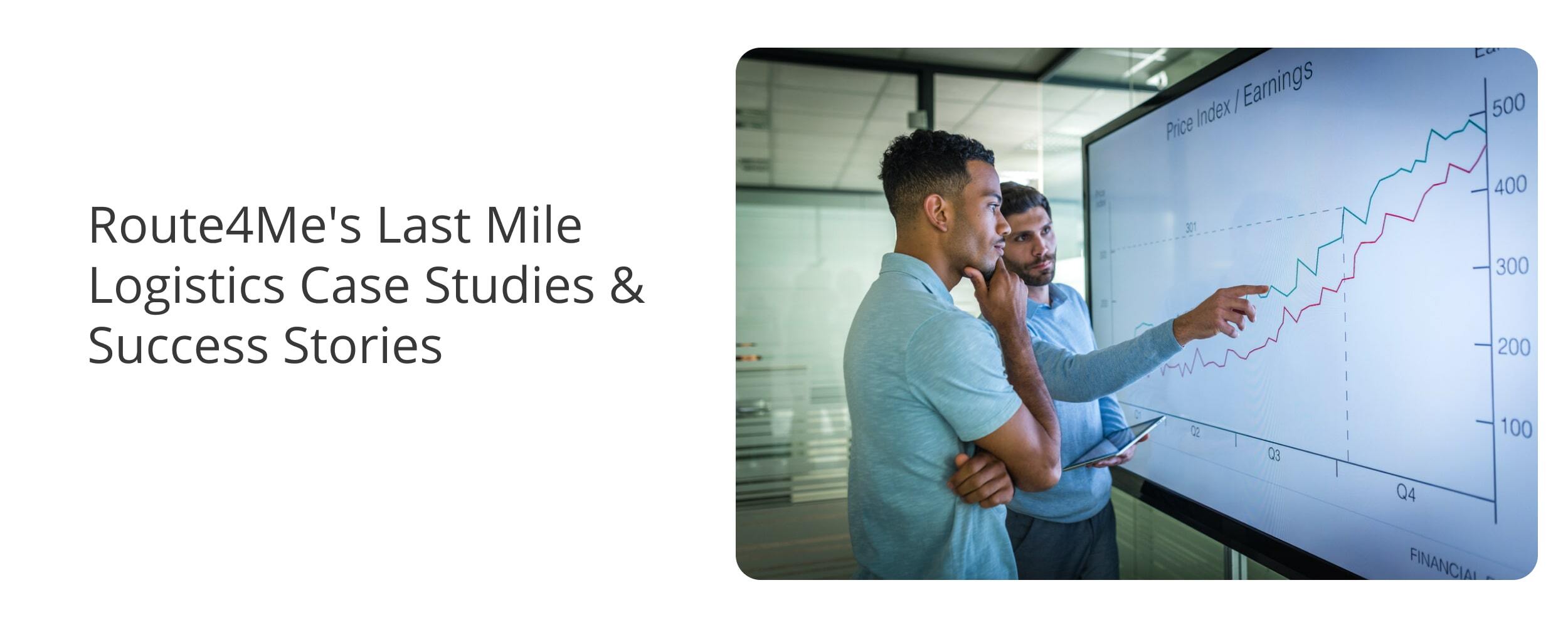
Final Mile Challenges 2024
The Covid-19 pandemic reshaped consumer behavior and accelerated eCommerce adoption, condensing 10 years of growth into as little as three months. Such drastic changes lead to skyrocketing last mile delivery volumes.
In 2024, not a lot has changed. Namely, the consumers still prefer online shopping to the detriment of brick-and-mortar stores. And this continues to impose challenges for last mile delivery businesses. Such last mile logistics challenges include:
- Keeping prices competitive considering rising costs and evolving customer expectations
- Managing greater volumes and higher capacity demands
- Increasing the total number of stops per route without investing in extra resources
- Offering new delivery service types, such as contactless delivery, click and collect, pickup, etc.
- Leveraging scalable efficiencies and identifying opportunities for growth
Read more about how the Covid-19 pandemic changes the last mile environment inside the linked last mile logistics book.
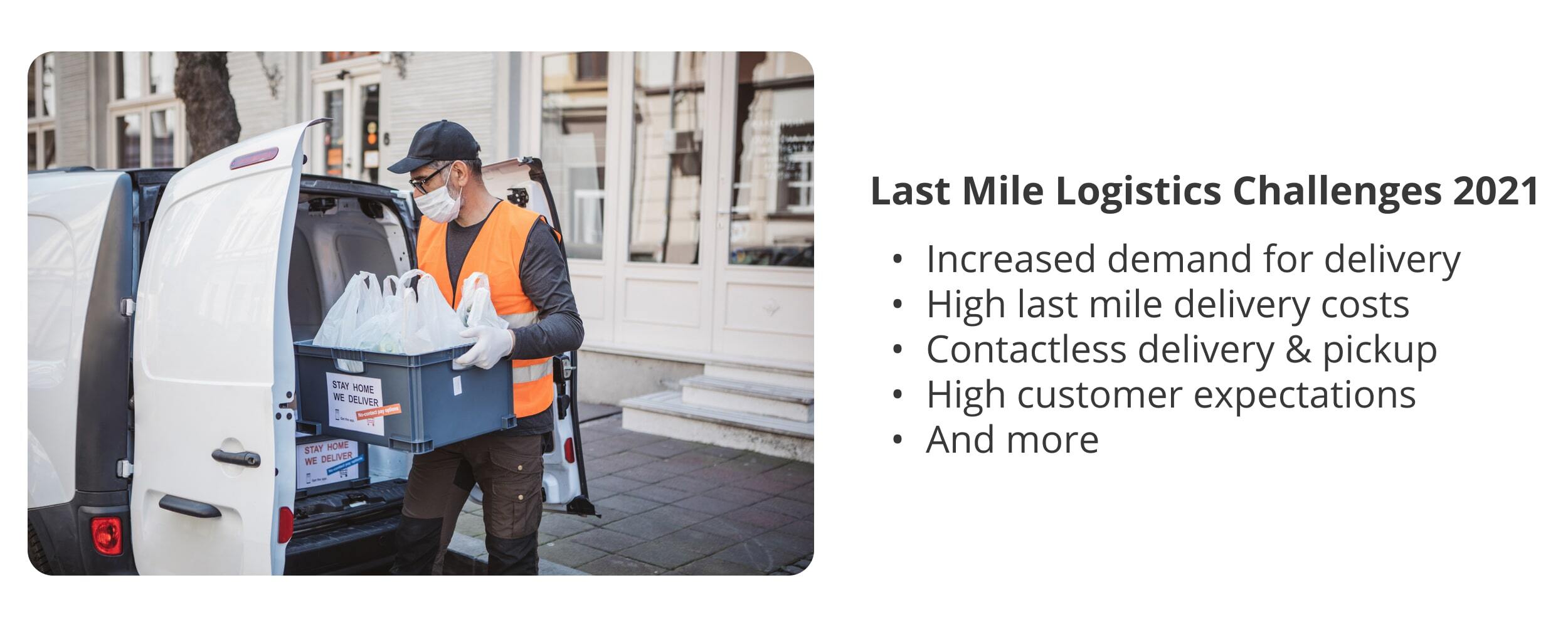
Final Mile Trends 2024
To tackle the challenges caused by the pandemic, carriers found new strategies to reduce costs and improve delivery productivity. For instance, delivery businesses started to partner up with competitors to increase their delivery capacity. This helped carriers meet the spike in demand and stay relevant in the market while the pandemic was unfolding. Other last mile logistics trends in 2024 include:
- Delivery appointment booking
- Contactless delivery
- Drones and delivery bots
- Curbside pickup
- Urban fulfillment centers
Learn more about the most recent supply chain trends on our blog.
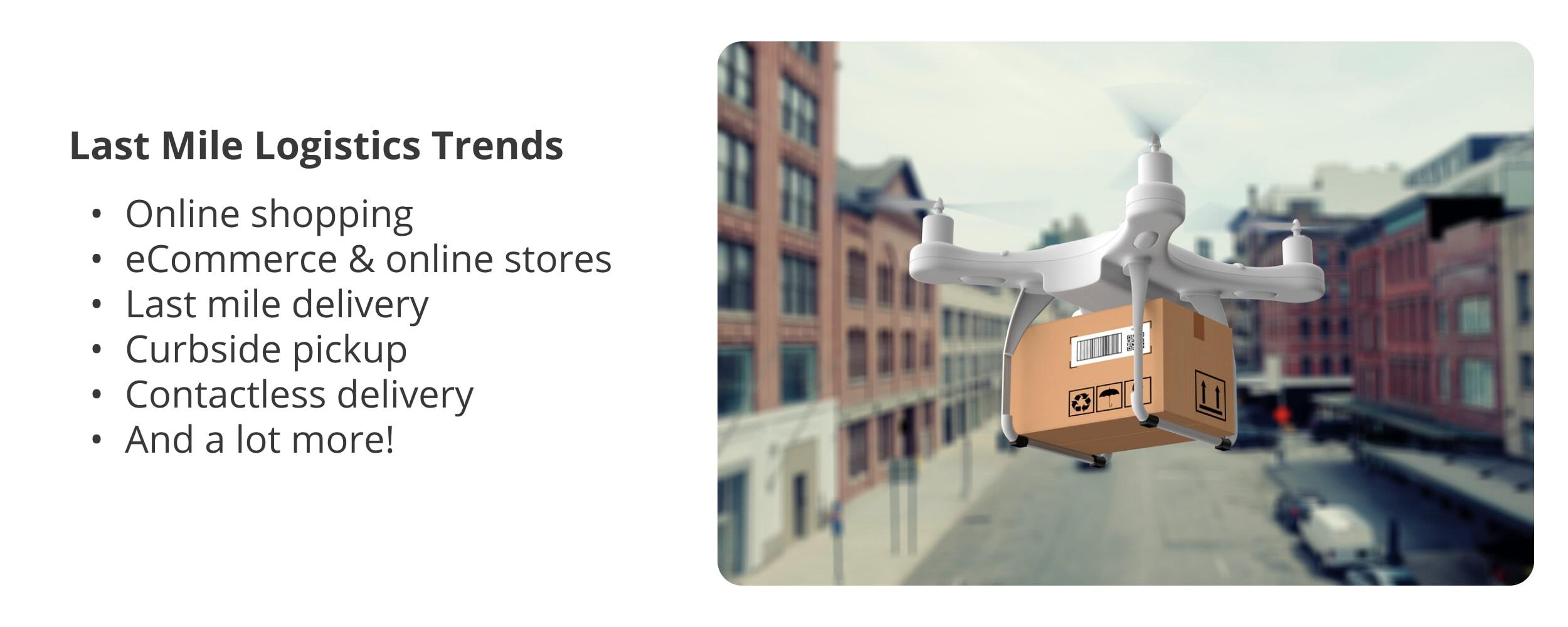
What Is Last Mile Logistics Software and Which One Is the Best for Your Business?
Last mile logistics software is also referred to as last mile delivery optimization software, a delivery route planner, quickest route planning software, logistics optimization software, and other similar terms. It helps logistics and fleet managers win the last mile by offering features such as:
- Route planning optimization, scheduling, planning, and dispatching
- Near real-time GPS asset tracking and digital proof of delivery
- Team, fleet, territory, and service area management
- Barcode support, order entry, and a lot more depending on your business needs
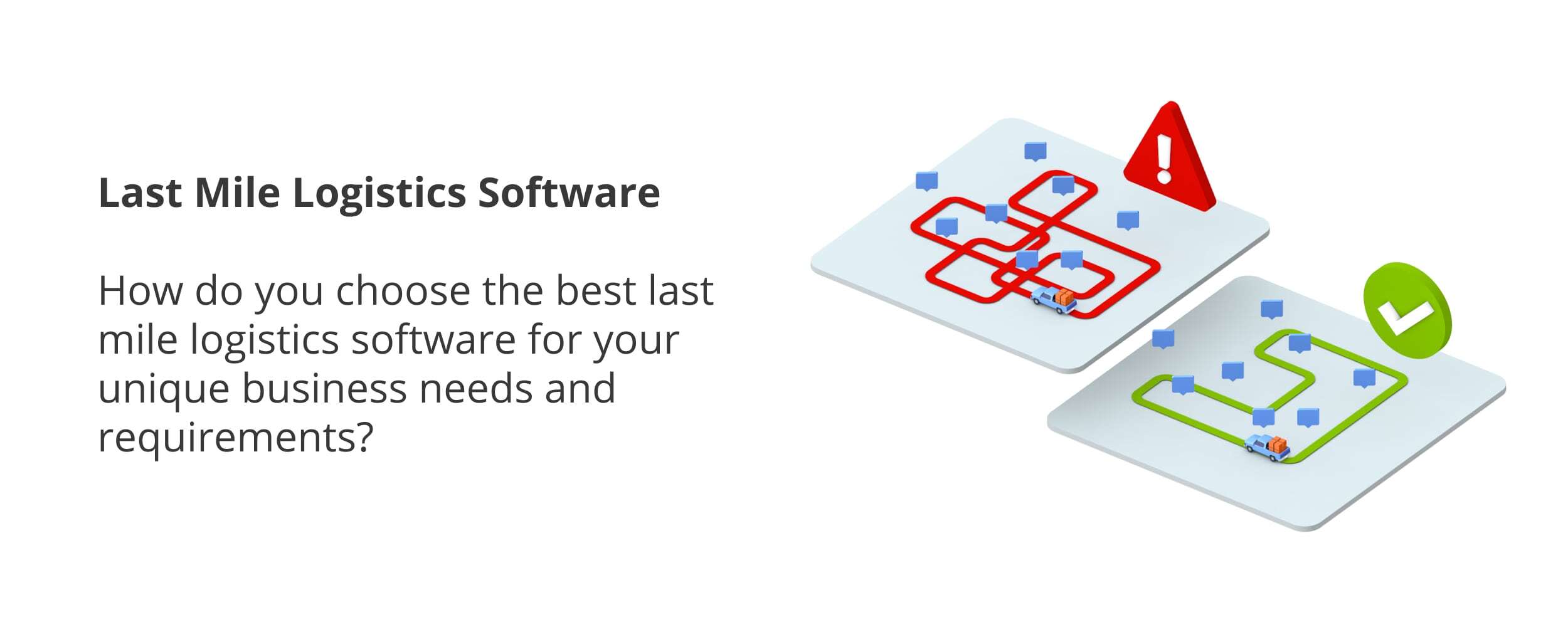
Below, you can gain insights about the most popular last mile delivery solutions in 2024. Plus, you will also get a brief overview of some of the features and capabilities that each platform provides:
- Locus Logistics Planning and Optimization Software helps users automate supply chain decisions.
- Onfleet Delivery Software offers multiple tools for local delivery management and last mile analytics.
- Track-POD Last Mile Delivery Platform features multiple route optimization, driver tracking, and electronic proof of delivery tools.
- Tookan Delivery Management Software helps delivery businesses digitize their last mile logistics operations and offers real time fleet tracking and route optimization features.
- Route4Me Last Mile Logistics Software provides supply chain professionals with flexible tools for fleet management, driver tracking, ePOD collection, route optimization, route dispatch, and more.
Free Last Mile Logistics Software Trial
Last mile logistics software is your ticket to unbelievable savings, incredible service, and a competitive edge. And to help you experience all this first hand, Route4Me enables you to sign up for a 7-Day Free last mile logistics software trial.
You’re not only getting premium logistics software for free for a whole week. But also, during the trial, you’re also able to actually plan routes with your REAL customers’ addresses. This is not just a simulation test drive. It’s an opportunity for you to leverage real operational efficiencies using your own routing data.
So, are you ready to win the last mile with Route4Me?
Sign up for the free last mile software trial today and start growing your profits in no time!
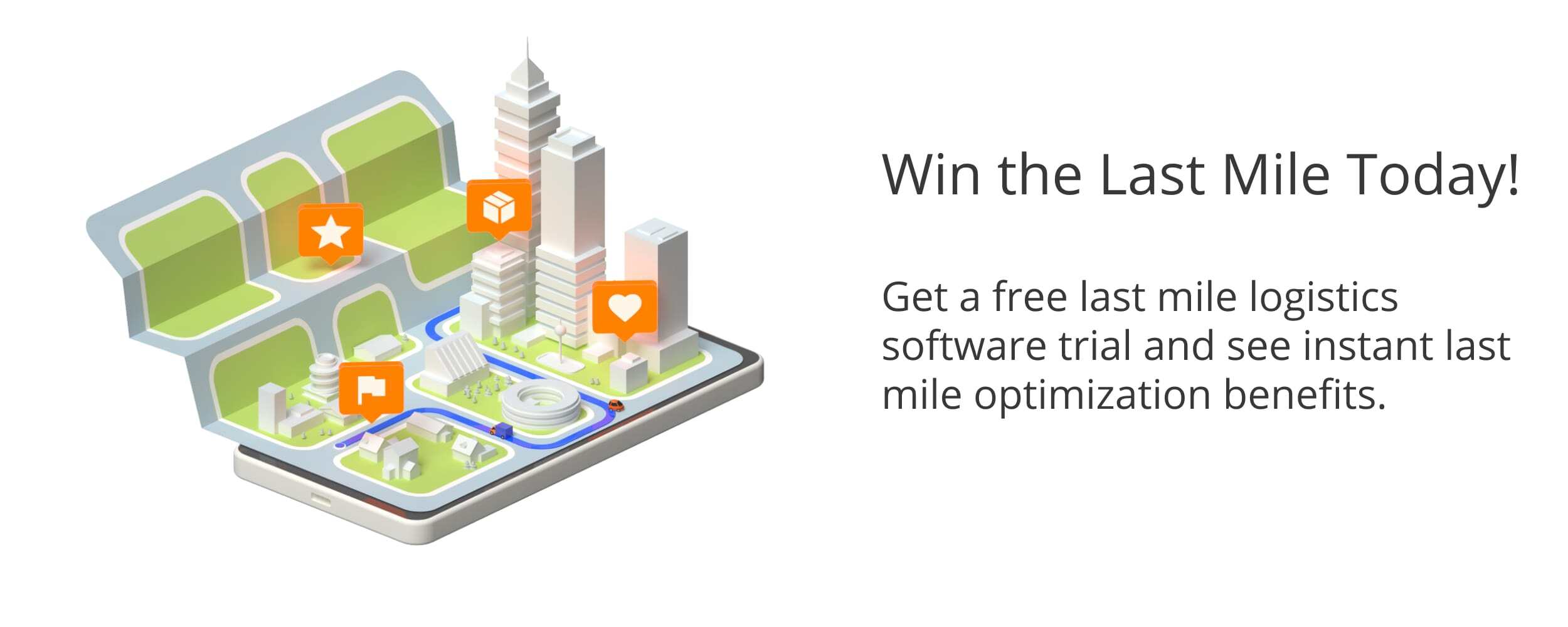
All the trademarks, logos, and brand names on this page are for identification purposes only. We do not endorse these trademarks, logos, and brand names. All the trademarks, logos, and brand names are the property of their respective owners. If any of the trademarks, logos, and brand names are your property or the property of your company, and you would like us to remove them from our website, please contact us at [email protected] to submit your request.
Last Updated: